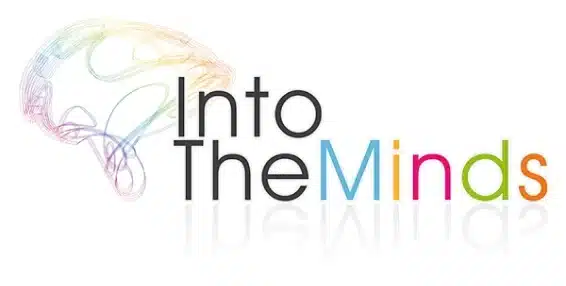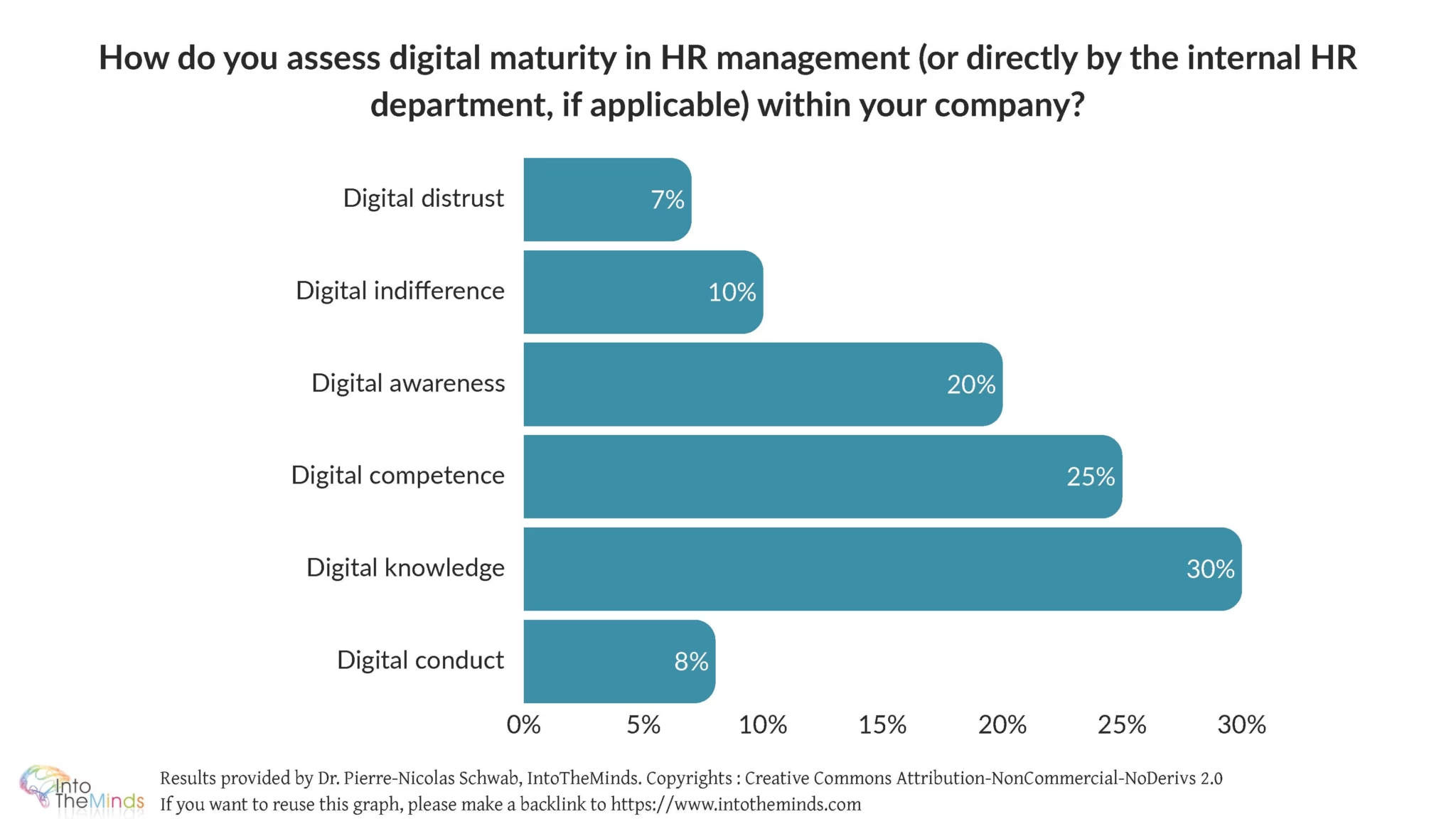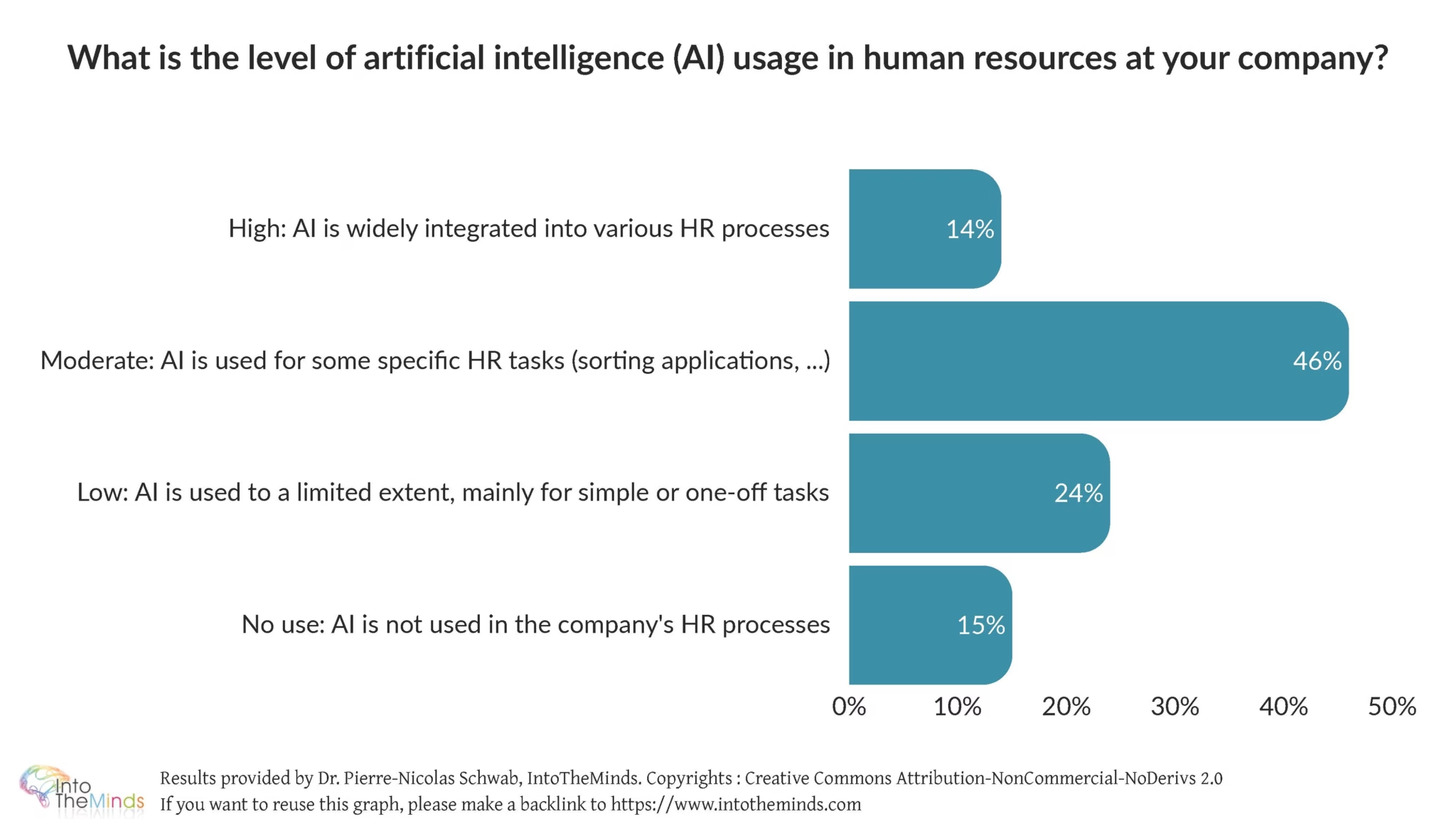Discover the results of a survey of 1,000 European companies on the digitalisation of HR processes in this study.
![Human resources: state of process digitalisation [Study]](https://5cc2b83c.delivery.rocketcdn.me/app/uploads/concept-shapes-scaled.jpg)
Digitalization of the HR function has become a major competitiveness challenge for companies. In 2025, digital applications dedicated to human resource management have penetrated nearly all companies. The study we conducted aims to understand the scope of this digitalization in European companies. We therefore surveyed 1000 companies in 5 countries (France, Italy, Spain, Germany, UK) to understand which digital solutions they use and how they assess their future needs.
We specialize in HR studies: contact us!
Digital maturity of European HR processes
Before anything else, we wanted to assess the digital maturity of the companies we surveyed. This type of assessment is fairly standard and allows us to verify the accuracy of subsequent responses. It’s a good practice when building a quantitative questionnaire and thus a quality issue for the study.
Beyond the purely technical aspect, this section of the survey is primarily intended to provide a first overview of the degree of digitalization of the HR function. The responses are based on the definition of digital maturity:
“Digital maturity refers to the level of development, integration, and effective use of digital technologies within an organization. It encompasses the company’s ability to adopt digital tools, transform its business processes, and create value through information technologies.”
The digital maturity scale we used consists of 6 levels (ranked below from the lowest level of digital maturity to the highest):
- Digital distrust: this is the lowest level. The company does not trust data and prefers other sources of knowledge for its management.
- Digital indifference: the company is not interested in collecting and using data for HR purposes.
- Digital awareness: data is collected manually and integrated into certain processes.
- Digital competence: the company uses data to produce standardized reports on an organization-wide reporting platform.
- Digital knowledge: the company uses data selectively to simplify decision-making.
- Digital leadership: the company integrates data into all decisions related to its management (no data, no decision).
We had already used this scale in a study of IT market trends. That’s why we reused it in this HR study, as there was a technological dimension.
The survey reveals that the majority of companies would use data for their HR decision-making processes. Logically, a minority of companies reaches the highest level (8% claim to be at digital leadership). But 30% estimate they are at the “digital knowledge” level, meaning they use data selectively to inform their HR decisions. 25% believe they reach the “digital competence” level, with standardized reports at the organization-wide level.
These percentages are high but do not seem incongruous in light of the benchmarks companies make when selecting candidates. There may be some overestimation of digital maturity, but ultimately, what needs to be retained is that the use of digital data is well diffused within HR processes. We find evidence of this digitalization of HR processes in the low percentages of the lower levels of the digital maturity scale:
- 7% of companies rank in the “digital distrust” category
- 10% declare themselves indifferent, meaning they do not collect data for HR purposes
We mainly find SMEs and small businesses in these last two categories, which is logical given their specificities. Given their characteristics, there is probably little chance that such companies will convert to data use. These can certainly represent levers for efficiency and innovation, but the sector, the company’s financial possibilities, and the manager’s personality must lend themselves to it.
I think that reports on process digitalization too often neglect to consider the necessity of digitalization and the gain/effort ratio. A manufacturing company will undoubtedly gain efficiency by analyzing its data. But what about artisanal, traditional trades? Is the game worth the candle?
Contact us for your HR and marketing studies
Adoption of digital HR tools and automation
Since companies seem to have converted to “data” in their HR processes, what about the tools they use? If you are an HR software vendor, these results should interest you.
Unsurprisingly, the most commonly used software solution by companies concerns payroll management. 45% of companies that responded to our survey are equipped with it.
In second place are Human Resources Information Systems (HRIS). These modular systems are offered by many companies, including several of our clients (Factorial, Personio, Adequasys, …). However, the percentage indicated by the data collected in our survey seems too high compared to what we observe in the market. This could indicate confusion on the part of respondents regarding the HRIS acronym, which designates a specific type of HR software.
We also note that 17% of companies declare not using any IT tools at all for their HR processes, illustrating a real digital divide.
Platforms like HRIS are essential for rationalizing processes such as payroll and compliance, while advanced tools—like satisfaction tracking—strengthen employee engagement and retention. Organizations that adopt IT tools generally report higher employee satisfaction and better operational efficiency. Conversely, those that delay adoption often face fragmented HR workflows. Research by Baker et al. (2022) underscores the need for digital tools supporting the entire employee journey, from recruitment to career development, to ensure a smooth experience for both employees and HR managers.
This fragmentation of HR process digitalization is also illustrated by the tension between integration (HRIS) and the “best-of-breed” strategy. This is a trend we observe in many companies we accompany.
Artificial intelligence and HR transformation
Our survey was conducted during the first half of 2025. Given the dynamics related to AI adoption in companies, remember that the figures we present below are likely to evolve rapidly.
The results show that, quite logically, the majority of companies do not yet use AI intensively in their HR processes. The majority of companies (46%) use AI at a moderate level, for example, for sorting applications. Only 14% of companies we surveyed have fully integrated AI into their HR processes. At the opposite end, 24% use it minimally, and 15% do not use it at all.
Beyond raw figures, I think we need to question this use of AI. The term AI can cover very different realities from one application to another. The competence threshold for using AI has significantly lowered since the introduction of generative AI. What I called Shadow GPT in another article has spread in all companies to the point that they no longer control its use. The same likely applies to AI in HR processes. It has become accessible to any recruiter today to use generative AI to respond to a candidate or draft a job ad. I invite you to read the ads published on major sites to see how similar they are in phrasing. ChatGPT has passed by there.
On the other hand, more advanced uses of AI remain reserved for more mature companies. And they naturally depend on the needs of these companies on the one hand, and the software they use on the other hand. The use of AI outside of ChatGPT and other LLMs is indeed strongly linked to the software used. Companies do not develop specific AI applications. They only use the features made available to them, and since AI infuses all software, adoption spreads.
Conclusion
HR processes, as we saw in this survey, are increasingly digitalizing. This is essential, because this field is becoming more and more complex. Personnel management has also become very complex, and digitalization offers the possibility to better manage careers, employee needs, in short, to increase retention. If digital tools are seen as a way to increase employee satisfaction, then they are clearly beneficial.
My position on AI in human resources is more nuanced. As we saw, its use is also tending to democratize. Studies had shown all the interest AI could have in reducing recruitment timelines by 40%. But in a world where tension in the labor market is easing, where supply is lower than demand, one can wonder what the point is. I also see drifts in its use. It seems to me that it is mainly a wave of use of generative AI that we are witnessing, with a impoverishment of the quality of certain procedures.
Ultimately, everything must always be brought back to satisfaction. Whether customer satisfaction or employee satisfaction, the goal is to promote retention. Processes, whether related to HR or any other area of the company, are there only to achieve this goal. Digital tools and AI must therefore be used keeping this goal in mind. In some companies, an HRIS software will be essential to achieve this goal. In others, a software covering only one part of HR work will be sufficient. The message I would like to convey is that it is the reality of the company that defines digitalization needs and not the other way around. Crossing the steps of digital maturity is therefore not an end in itself.
Would you like me to then provide a revised version in terms of style (fluidity, coherence, clarity) without changing the substance?








![Illustration of our post "Colruyt champion of price changes [Research]"](https://5cc2b83c.delivery.rocketcdn.me/app/uploads/pricing-120x90.jpg)


